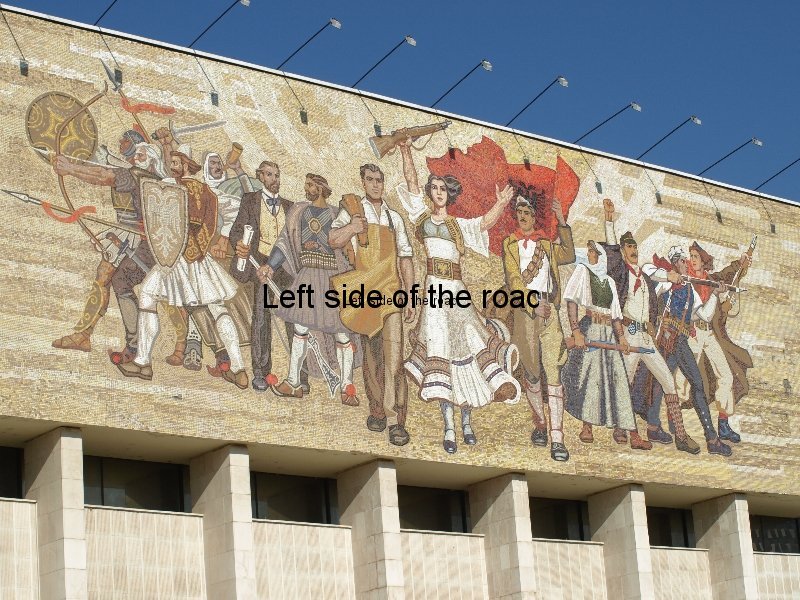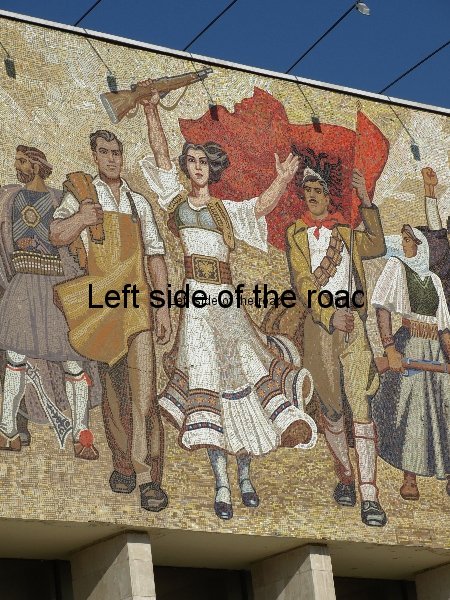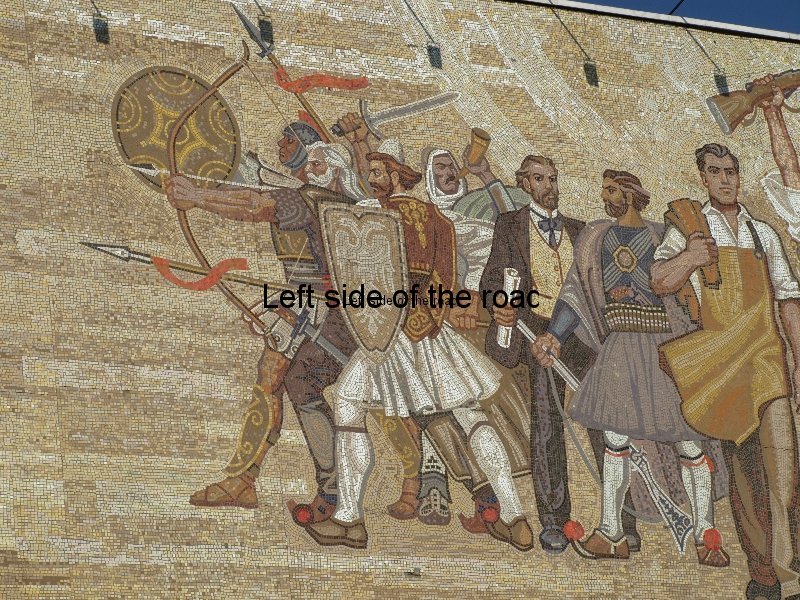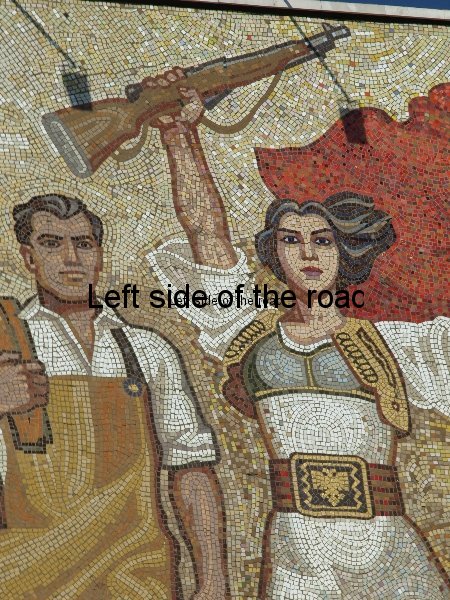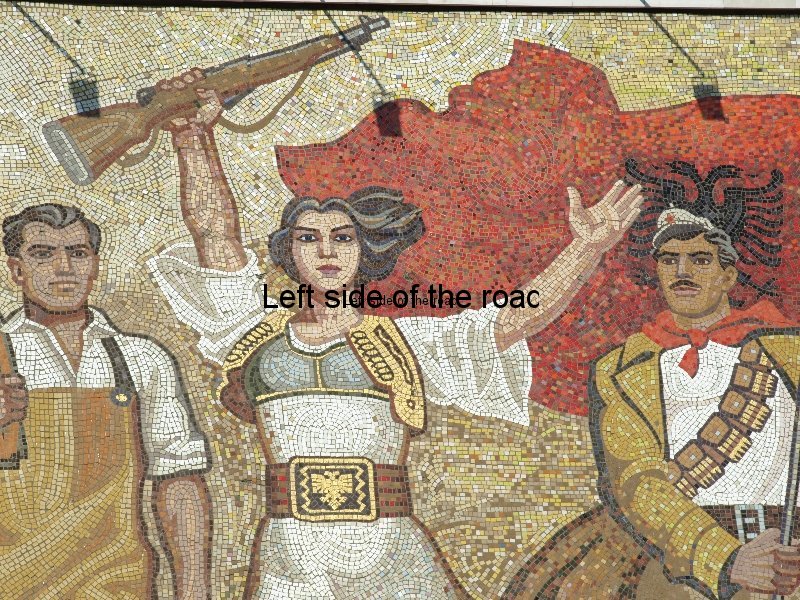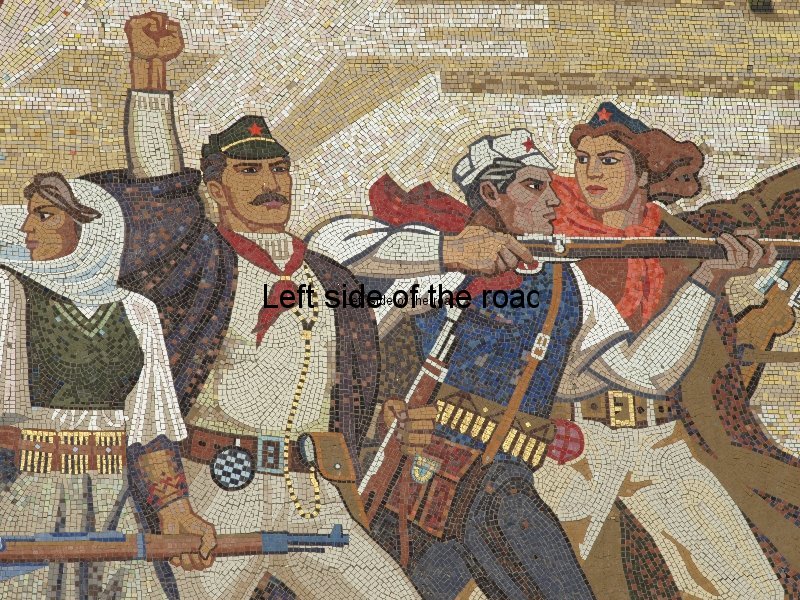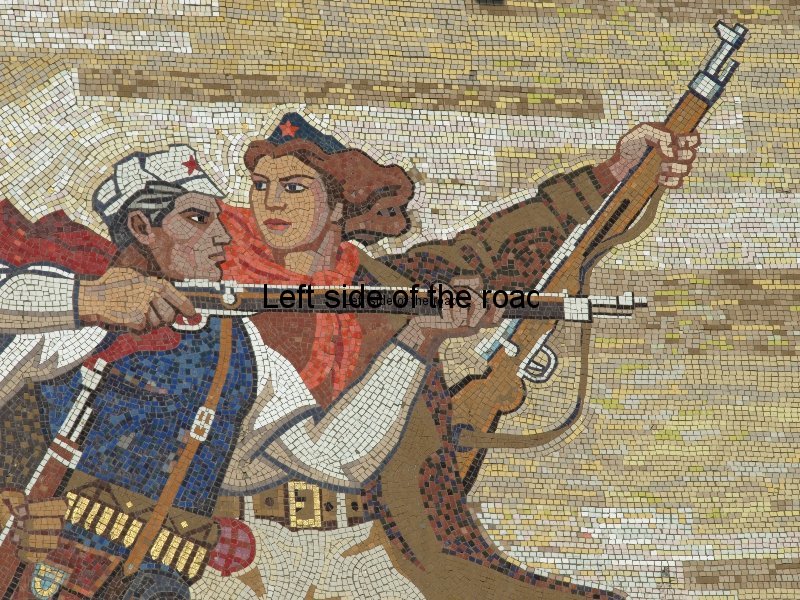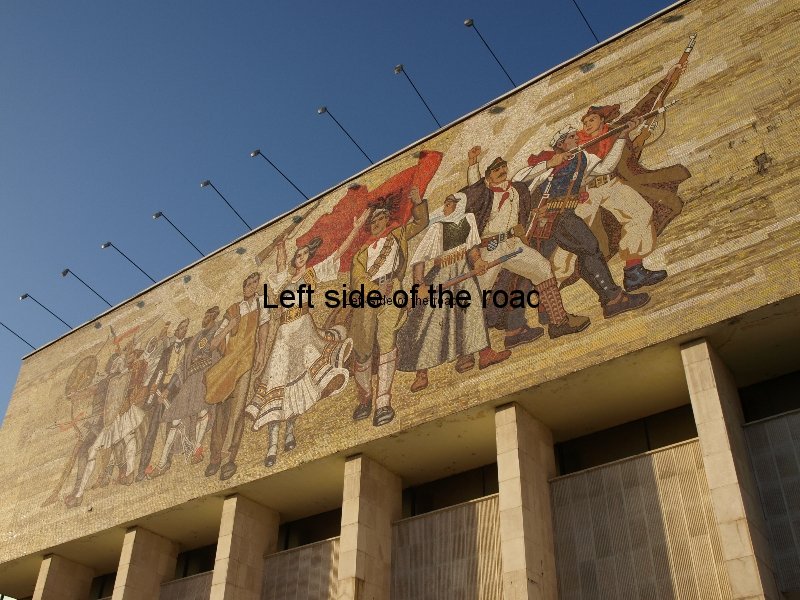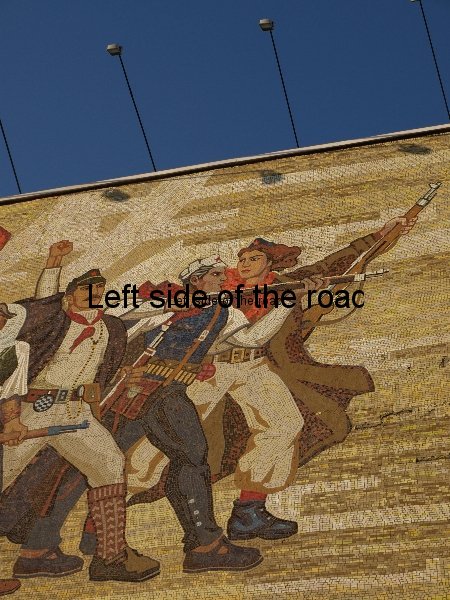‘The Albanians’ Mosaic, National Historical Museum, Tirana
‘The Albanians’ mosaic on National Historical Museum, Tirana, is one of the finest examples of late Albanian Socialist Realism still to be seen in the country.
For most visitors to Albania the example of Socialist Realist art they would have seen is the mosaic, called ‘The Albanians’, situated above the main entrance of the National Historical Museum in Skënderbeg Square, Tirana.
The work is the result of a collective of five Albanian artists – Vilson Kilica, Anastas Kostandini, Agim Nebiu, Justin Droboniku and Aleksander Filipi – and was completed in 1980 for the opening of the museum.
This is huge, covering 400 m², and dominates one end of the main square in Tirana. Fittingly, as it decorates a historical museum, it tells the story of how Albanians have fought against invasion and occupation throughout the centuries. Being one of the smallest states in the Balkan region (until the former Yugoslavia was broken up into smaller and even smaller western friendly ‘nations’) Albania was considered fair game by whatever was the dominant imperialist power around at the time.
Before talking about the mosaic in some detail a quiz question. Take a look at the picture at the top of this post and see if you can work out what is particular to the three women depicted, in a form that you are unlikely to see in any capitalist country?
On the left as you look at it is concentrated almost 2000 years of defiance towards the invaders, going back to the Roman Empire, which later changed to Byzantine control, that being usurped by the Bulgars, from what is now modern-day Bulgaria, in the 7th century. The major, and longest, running battle was against the efforts of the Turkish Ottoman Empire to control the small mountainous country, this being the period when Skënderbeg became the national hero. All these invading cultures have left their mark on the culture, architecture and language of the Albanians. Also among this group is the representation of Albania’s Declaration of Independence in 1912 – the man in a suit with a piece of paper on his hand is Ismail Qemali.
On the right is depicted a very specific and the most recent and most successful National Liberation struggle, the one against, first Italian and later German, Fascism between 1939 and 1944. The red star on the caps of three of the four individuals indicate they are Communist Partisans, where armed men and women fought side by side.
The trio in the centre represent, what was then the present in 1980s Albania, workers in control of their country, the red flag flying, the guns in the hands of the workers and united they are marching forward to a Communist future. That march has been halted, temporarily, but there is still an element of hope depicted in the determined way the trio are walking towards the viewer.
However, what you see is not the original. Sometime after 1990 (I’ve yet to discover exactly when ) the mosaic was ‘depoliticised’, at least partially. There were probably those who wanted to see the total destruction of the mosaic (as has happened in other places, such as the wall of the National Library just across the square from the Historical Museum and the monument to the ‘Four Heroines of Mirdita’) but the compromise was, nonetheless, cultural vandalism.
And the ‘artist’ responsible for this crime was one of the five who created it in the first place. The criminal’s name is Agim Nebiu. He didn’t do so for any political reason, he did it for money. Like so many artists he was/is cheap. One of the problems with ‘intellectuals’ and ‘artists’ under Socialism is that they are so ‘special’ (or they think themselves as such) that they throw a hissy fit if they are expected to create something which might not fit into their ‘artistic’ sensibilities.
If from a working class or peasant background they would never have had the chance to learn their trade if it were not for the Socialist Revolution but once having gained those skills they turn their backs on the people who provided them with previously unheard of opportunities. They adopt the attitude of many ‘artists’ under the capitalist social system, that they should be ‘free’ to ‘express their creativity’. That they hold no debt to those workers who have enabled them to have the luxury of a higher education. When someone throws thirty pieces of silver on the table they grab them with both hands. They declare that now they are ‘true artists’, not following the diktats of the state. They are no such thing. At least prostitutes are honest.
Stars are crucial to Albanian Socialist Realist Art. They determine the meaning of the story. There is no shadow of a doubt that the Fascists would not have been thrown out of Albania, by the Albanian people themselves, if it were not for the political direction given to the struggle by the Marxist-Leninists, those members of the then Albanian Communist Party (later to be renamed as the Party of Labour of Albania).
The self-proclaimed ‘king’ Zog fled when the Italians landed in Durres in April 1939 and lived in luxury in Britain. The nationalists of Balli Kombëtar sat down with the Nazis and were bombarded by the Communist Partisans from the hills of Sauk. True partisans, like young Liri Gero – a true daughter of her country and living up to the meaning of her name (Freedom) and who was tortured to death by the odious Nazis – followed the Communist banner. On that banner was the golden star of Communism.
That star was anathema to the counter-revolutionaries who gained power after 1990 and throughout the country that symbol, so hated by capitalism and its lackeys, has been the target of official and unofficial vandalism.
The mosaic is an example of the official.
Below is a detail of the original mosaic, as it was planned and executed by the group of five artists in 1980.

National Museum Mosaic – original
Notice that there is a large golden star above the head of the woman in the centre of the picture. If you now look at the close up of that middle section below can you spot an anomaly?
Doesn’t the flag look a strange shape? Flags are normally rectangular but this one looks like it’s a piece of cloth cut totally at random. That’s because the corner of the flag between the woman’s head and her upraised rifle is where the star used to finish. What has happened is that the gold star pieces of ceramic have been removed, replaced by reddish pieces and then a bump of red inserted between the original folds of the flag and the corner. If the flag followed its original shape the corner would have been behind the woman’s head.
The pieces of ceramic are also a slightly different colour and they have a different orientation to the originals. It must have been difficult to get exactly the same pieces at least 20 years after the original was installed – not least because all the factories that would have made the original tiles have been closed down and now lay derelict.
You’ll notice the same disparity if you look above the twin eagle heads on the flag. During the Communist era there was a small gold star here and that also has been obliterated, but a close examination of the area shows that something is amiss.
A third change is to the depiction of the male character on the right of the central female.
Originally he carried a red book in his right hand, holding it against his chest. In the vandalised version he carries something that looks like a sack. This is plainly ludicrous. In all forms of art, especially Socialist Realist art, everything has a meaning. Carrying a book means education (denied the majority of the population before 1944 and something that was a principal aim and achievement of the Socialist society – although there has been much privatisation of education in Albania in the last 25 years the popularity of the annual book fair in Tirana in November shows the love that still exists for books within the country). Carrying an empty sack means … what? The same as in the empty sack … nothing!
To have just removed the book would have meant that the character would look strange. Why have an empty hand across his chest. In the context of the three of them marching it would be more realistic if his right arm was hanging down by his side as people do when marching when not carrying anything.
To have changed his stance would have been a major task indeed so Nebui took the easy way out and substituted the book with the sack.
If it is easy enough to understand why the stars were removed it begs some interesting questions when we talk about a book.
This is tantamount to book burning – which did take place outside what is now the Adrion book shop just across the square during the counter-revolution of the early 1990s. To me it’s also symbolic of the attack on education for all, at the state’s expense, a principal of all Socialist states in the past but something which has also been privatised in all post-Socialist states. Education is now a privilege and not a right.
When I first went to Tirana in November 2011 the whole of the front of the building was covered with scaffolding, which was finally removed in time for the Independence Day celebrations on the 28th. I don’t know what sort of work was carried out on the mosaic but what surprises me is that the red stars on the caps of the Communists have survived.
Now the answer to quiz posed at the beginning. ALL the women are carrying arms! OK, there’s only three of them but that’s still a hundred per cent. And this is quite common in the depiction of women in Albanian lapidars, such as in Fier, Lushnjë, Saranda, Librazdh, Pishkash, the,sadly destroyed monument to the Four Heroines of Mirdita, the first Party Cell in Proger, Liri Gero and the 68 Girls of Fier, the Drashovice Arch and many others yet to be written and posted.
But apart from the ‘official’ re-writing of history we have neglect. Just from the street it is possible to see that the mosaic is starting to crumble. Bits are falling off and there’s obviously no concern to repair a unique piece of art, even from the Social Democrat government at present in place. That shouldn’t be a surprise. Tony Blair, the traitorous warmonger who was able to woo the British population to his mock Tory politic, now ‘advises’ his protégé, Edi Rama, himself the son of an Socialist sculptor and a trained artist, but basically a philistine more intent on self-enrichment than the preservation of his country’s culture.
Close up photos show just how bad the deterioration has become.
At the same time I don’t have a problem with this. I think this mosaic is one of the finest pieces of Socialist Realist Art in Albania but the present population doesn’t deserve it. I see no reason why works of art that celebrate the working class and its struggle for Socialism should exist in a country where the vast majority of its young people want to leave in order to live in a capitalist ‘heaven’, many of its young women populate the brothels of Europe and their principal export is vicious, murderous gangsters. (There’s study to be made why post-Socialist societies produce such scumbags.)
Wonderful as such art is, and making a statement that has yet to be fully developed, celebrating the working class in a manner that has never been made before, a working class that doesn’t struggle for a better future doesn’t deserve such art.
Let them live with the banality of the celebrity culture, reality TV, cake making competitions, Coca Cola and McDonald’s. Until they attempt to change the world for the betterment of themselves and those that follow that’s all they are worth.
The slideshow below shows some of the detail of the mosaic and also, sadly, signs of neglect and cracks in the design itself. If something isn’t done soon we will find pieces of ceramic falling on the heads of those entering the museum.



